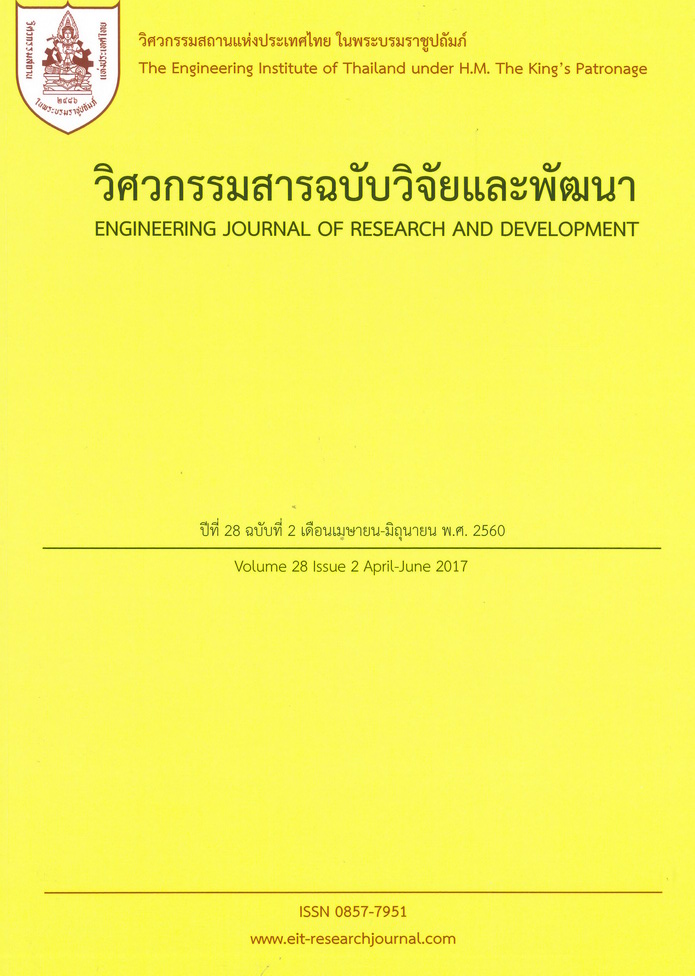ความสัมพันธ์ระหว่างความหนาแน่นสัมพัทธ์ของทรายกับสัมประสิทธิ์แรงดันดินด้านข้างในสภาวะสมดุล
Main Article Content
Abstract
งานวิจัยนี้มีวัตถุประสงค์เพื่อศึกษาความสัมพันธ์ระหว่างความหนาแน่นสัมพัทธ์กับค่าสัมประสิทธ์แรงดันด้านข้างของทรายในสภาวะสมดุล (Ko-conditions) ตัวอย่างทรายที่ใช้เป็นทรายสะอาดที่ไม่มีความเชื่อมแน่น (Cohesionless clean sand) 3 ขนาด ได้แก่ ทรายขนาดเส้นผ่าศูนย์กลางประมาณ 0.2 มม., 0.6 มม. และ 1.0 มม. ตัวอย่างทรายถูกเตรียมขึ้นโดยมีค่าความหนาแน่นสัมพัทธ์ (Relative density, R.D.) ของตัวอย่างทรายที่ระดับต่าง ๆ ได้แก่ 20%, 40%, 60% และ 80% การศึกษาวิจัยครั้งนี้ ได้ทำการวัดค่าสัมประสิทธ์แรงดันด้านข้างของทรายในสภาวะสมดุล (Ko) โดยใช้เครื่องมือ Modified Ko-Oedometer ที่ประดิษฐ์ขึ้นซึ่งสามารถใช้ในการวัดค่า Ko ได้โดยตรง เครื่องมือ Modified Ko-Oedometer ที่ใช้ในการศึกษาวิจัยครั้งนี้มีลักษณะเป็นทรงกระบอก ที่มีการเจาะรูวงกลมไว้ที่ผนังด้านข้างของทรงกระบอก พร้อมทั้งมีการติดตั้งระบบการวัดแรงเอาไว้ ทำให้สามารถวัดหน่วยแรงประสิทธิผลในแนวราบของทรายได้ จากนั้น ค่า Ko ของทรายที่ระดับ R.D. ต่างๆ คำนวณได้จากอัตราส่วนระหว่างหน่วยแรงประสิทธิผลในแนวราบ (s¢h) กับหน่วยแรงประสิทธิผลแนวดิ่ง (s¢v)
RELATIONSHIP BETWEEN SAND RELATIVE DENSITY AND EARTH PRESSURE COEFFICIENT AT-REST
This research aims to study the effect of sand relative density on the value of later earth pressure coefficient (Ko). Three sizes of clean sands with diameter of 0.2 mm., 0.6 mm. and 1.0 mm. were prepared. Sand specimens at relative density of 20%, 40%, 60% and 80% were prepared into a cylindrical mold of an invented modified Ko-oedometer. The mold of the device has a circular hole that is connected to a load cell. When vertical effective stress is applied at the top of specimen, the soil settles but tends to expand laterally. The lateral deformation of specimen was recovered back to zero lateral strain position and load cell could measure the effective lateral earth pressure at Ko-conditions. The values of Ko were then determined by the ratio of horizontal effective stress (s¢h) to vertical effective stress (s¢v)
Article Details
The published articles are copyright of the Engineering Journal of Research and Development, The Engineering Institute of Thailand Under H.M. The King's Patronage (EIT).

